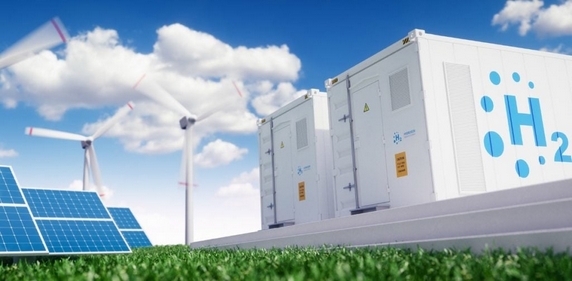
Increased electricity demand for green hydrogen production will give solar PV a boost in Southeastern Europe. Image: Toshiba Corporation.
The renewable energy landscape in Southeastern Europe (SEE) is poised for significant transformation with green hydrogen production via electrolysis emerging as a key driver. This article delves into how green hydrogen can act as a catalyst for increasing demand, stabilising electricity prices, and fostering the sustained development of solar photovoltaic (PV) systems in the region.
The COVID-19 pandemic and subsequent fluctuations in gas and power prices initially stalled demand growth in Europe, particularly in SEE. However, as the electrification of other sectors, such as heating and transportation progresses, the overall electricity demand is set to increase in the coming decade. More significantly, the surge in demand driven by green hydrogen production via electrolysis is expected to be substantial and one to watch.
Countries like Greece and Romania are setting ambitious targets for hydrogen integration but it is inevitable for the rest to stay far behind. According to Greece’s National Energy and Climate Plan (NECP), the country anticipates over 1 TWh of power demand for electrolysis just in the next five years, escalating to a staggering 63.6 TWh/year of hydrogen consumption by 2050. Romania’s latest draft NECP targets hydrogen to provide 5% of all energy used in transport by 2030 and aims for all gas plants to run on hydrogen by 2035. Aurora’s analysis projects a demand range of 33 to 47 TWh for green hydrogen production across SEE countries by 20601. To put things into perspective, this could alone mean between 24GW to 34GW of solar PV capacity by 2060 for generating enough electricity to power these electrolysers2.
This expected surge in demand from hydrogen electrolysis can significantly boost the need for renewable energy sources. In Greece, for instance, there are already concerns about whether existing demand levels can accommodate the planned new renewable energy projects. Hydrogen electrolysis could alleviate these concerns by creating additional demand, thereby providing more room for renewable energy plants to operate efficiently.
Green hydrogen production not only increases total electricity demand but also favourably influences the demand pattern, particularly benefiting solar PV. Electrolysers require low electricity prices to produce cost-competitive hydrogen. These low prices typically occur when solar PV generation is at its peak, usually around mid-day.
In scenarios where electrolysers are grid-powered, they are likely to operate during hours of high solar PV penetration. Renewable energy sources, especially solar, have low operating costs and, therefore, reduce electricity prices when they dominate the supply. This phenomenon, known as the “cannibalisation effect,” can lead to lower revenues for solar PV operators as more low-cost generation enters the system.
However, the integration of hydrogen electrolysers can mitigate this effect. By absorbing excess power during periods of low prices and high solar generation, electrolysers help stabilise prices and prevent frequent price collapses. This not only supports solar PV operators by maintaining more favourable price levels but also aids in avoiding curtailment, where excess energy generation is wasted.
Green hydrogen production via electrolysis holds the potential to be a game-changer for the renewable energy sector in Southeastern Europe. By driving up electricity demand and creating favourable demand patterns, hydrogen can play a crucial role in the region’s energy transition. The combination of hydrogen production and solar PV generation promises a more resilient, efficient, and sustainable energy future for SEE. As countries in the region continue to set ambitious targets and invest in renewable energy technologies, the integration of green hydrogen will be pivotal in realising these goals and ensuring a stable and growing market for solar PV.
[1]Low end reflects Aurora’s low scenario while the high end Aurora’s high scenario. This analysis includes 7 countries comprising of Greece, Bulgaria, Romania, Hungary, Serbia, Croatia, and Slovenia.
[2]Assuming a 16% average solar PV load factor across the region.
Panos Kefalas is research lead expert of Southeastern Europe at Aurora Energy Research, a power market analytics company based in Oxford, UK.
(The above content is reproduced from pv-tech,By Panos Kefalas)
Disclaimer: This website reproduces information from cooperative media, institutions or other websites. The publication of this article for the purpose of transmitting more information,and it does not imply endorsement of its views or confirmation of the authenticity of the content. All information on this website is for reference only and can’t be used as the basis for transactions or services. If there are any infringement or other issues in the content of this website, please notify it in time, then this website will be promptly modified or deleted. Anyone who logs in to this website in any way, or directly or indirectly uses the information on this website shall be deemed to have voluntarily accepted the binding of this website statement.